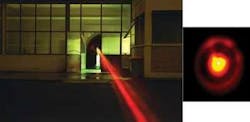ULTRAFAST LASERS: Plasma filaments produce terahertz radiation
With an increasing number of terahertz-radiation schemes being developed, nothing could be more satisfying to a terahertz researcher than the creation of a new type of terahertz source from an existing photonics technology. French researchers have happened across just that: a forward-emitting source of terahertz from the filamentation caused by focusing femtosecond lasers in air.1
Terahertz generation presents difficulties in part because terahertz frequencies are lower than those typically involved in optical techniques but higher than those for electronics-based techniques. One successful approach has involved nonlinear optical schemes in which a laser fundamental and its second harmonic are overlapped, leading to plasma formation and terahertz generation. Such methods are constrained, however, by the need for precise alignment and short path lengths.
On the other hand, a single femtosecond beam can create filaments that travel over great distances. The self-focusing of femtosecond lasers comes about because of an intensity-dependent refractive index; above a certain intensity, multiphoton ionization of air causes a defocusing of the beam. It is a dynamic balance between these two processes that leads to narrow filaments that maintain their high intensities even over very long distances (see figure).
It was predicted in 20012 and demonstrated in 20033 that terahertz radiation could be produced by the plasma wakes of filaments-but only in a radial direction. Following this lead, Andre Mysyrowicz and colleagues at the Ecole Polytechnique (Palaiseau, France) used the Teramobile laser-which recently made news for creating long-lived conducting filaments (see www.laserfocusworld.com/articles/294626)-to create filaments for terahertz generation. “There was a prediction that these filaments should emit radially. In fact, we were measuring that first,” says Mysyrowicz. What the researchers found was a source of radiation emitting in a cone shape in the beam-propagation direction. The group then began collaborating with Vladimir Tikhonchuk at the University of Bordeaux (Talence, France) to reason out a theory for the emission.
Cerenkov-type emission
The researchers postulate that the filaments leave a weakly ionized plasma in their wake; the space charge created behind the plasma ionization front propagating at the speed of light leads to Cerenkov-type terahertz emission. The resulting theory predicts that the emission peak should occur between 1 and 5 THz; for now the group has only measured the component around 0.1 THz. There is also evidence that the pulse width of the optical beam shortens as it propagates along the filament.
Hartmut Roskos, a researcher at the University of Frankfurt and a pioneer in the optical-rectification approach to terahertz generation, is intrigued by the result. “If I start out with a 100- to 200-fs-long pulse, the pulse shortens to the 10 fs range after some distance,” he says. “This is spectacular. For terahertz generation, it implies that one can generate very-high-bandwidth terahertz pulses.” However, Roskos says that a significant limitation to the method will be that the conical emission will be hard to collect and put to good use.
The research has moved forward since the group submitted its first results. A key concern is the full spectral and temporal characterization of the pulses generated with the new method; the group is experimenting with the effect in different gases. But the fact that it is accomplished in air is perhaps its strongest point. “This solves a longstanding problem with terahertz applications: terahertz radiation experiences a strong attenuation in air due to water vapor,” Mysyrowicz says, noting that the magnitude of the attenuation is on the order of 100 db/km. Most interestingly, he says that a simple modification to the approach has increased the forward-emitted terahertz intensity by an order of magnitude, but is loath to discuss the details until the group’s paper is accepted.
A key feature of using filamentation as the terahertz source is the long-distance nature of filament propagation. “Because it is very easy to displace the onset of filamentation over distances ranging up to hundreds of meters from the laser, one can bring the terahertz source in the immediate proximity of a distant target,” says Mysyrowicz. The displacement can be accomplished by introducing a chirp to anticipate group-velocity dispersion in the propagation medium and adjusting the focusing properties, in a kind of terahertz ventriloquism. The group has shown a proof-of-principle experiment generating terahertz at a distance some 30 m from the laser.
Mysyrowicz is clearly already thinking of applications. “By rastering the laser beam over the target, one should be able to perform imaging,” he says. He believes that such long-throw imaging could find application in medicine or security.
REFERENCES
1. D’Amico et. al., Phys. Rev. Lett. 98, 235002 (2007).
2. Cheng et. al., Phys. Rev. Lett. 87, 213001 (2001).
3. G. Méchain et. al., Appl. Phys. B 77, 707 (2003).
